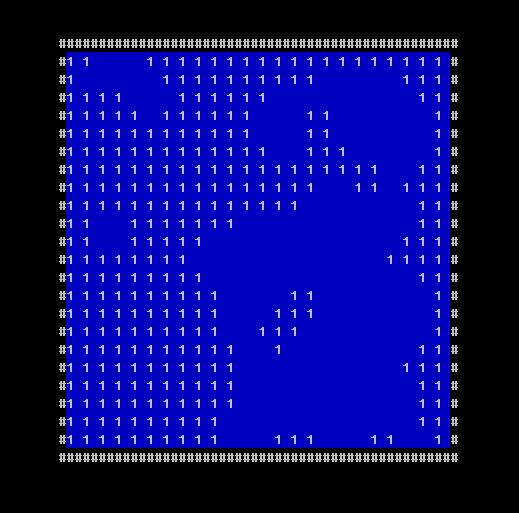Using TypeScript to Generate a Map with Cellular Automata
This is an example of how to use TypeScript in NodeJS and generate cellular automata on a map and render it with console or with a normal JavaScript node library.
As our sample node library we will be using blessed to render the map in a colorful terminal prompt in addition to a standard console.log.
Setup
Our directory structure will look like:
build/
node_modules/
src/
main.ts
main-blessed.ts
map.ts
package-lock.json
tsconfig.jsonThe contents of our tsconfig.json file includes a standard build process that takes all in src/ and outputs it to JS in build/.
{
"compilerOptions": {
"outDir": "./build",
"allowJs": true,
"target": "es5",
"types": ["node"]
},
"include": ["./src/**/*"]
}We are going to install two node packages:
npm install @types/nodeso that the TypeScript compiler knows how to use NodeJS librariesnpm install blessedso we can render- If you have not installed typescript do so globally with
npm install -g typescriptso we can compile withtsc
Map Module
We will start by defining the map module in TypeScript that includes the Map and Cell classes that we will use to simulate a map and generate cellular automata with.
In src/map.ts
// Cell class is a single cell in our map and has an
// index on our parent map as well as row, column and
// value
export class Cell {
index: number;
r: number;
c: number;
value: number = 0;
constructor(index: number, r: number, c: number) {
this.index = index;
this.r = r;
this.c = c;
}
}
// Represents a map of rows and columns and contains
// a set of Cells to represent values
// Can initialize them to empty or run cellular
// automata against them
export class Map {
rows: number;
columns: number;
cells: Cell[];
constructor(r: number, c: number) {
this.rows = r;
this.columns = c;
this.cells = [];
let i: number = 0;
for (let r: number = 0; r < this.rows; r++) {
for (let c: number = 0; c < this.columns; c++) {
this.cells.push(new Cell(i, r, c));
i++;
}
}
}
public clear() {
for (let r: number = 0; r < this.rows; r++) {
for (let c: number = 0; c < this.columns; c++) {
let index = r * this.columns + c;
this.cells[index].value = 0;
}
}
}
public toString() {
let p = '';
for (let r = 0; r < this.rows; r++) {
for (let c = 0; c < this.columns; c++) {
let index = r * this.columns + c;
if (this.cells[index].value == 0)
p += ' ';
else
p += this.cells[index].value + ' ';
}
p += "\n";
}
return p;
}
// Main entry point for running cellular automata
public cellify(aliveChance: number = 0.4, deathMax: number = 3, birthMax: number = 4, steps: number = 2): void {
this.cellInit(aliveChance)
for (let i: number = 0; i < steps; i++) {
this.cellSimulate(deathMax, birthMax);
}
}
private cellInit(aliveChance: number) {
for (let r: number = 0; r < this.rows; r++) {
for (let c: number = 0; c < this.columns; c++) {
let index = r * this.columns + c;
if (Math.random() < aliveChance)
this.cells[index].value = 1;
else
this.cells[index].value = 0;
}
}
}
private cellSimulate(deathMax: number, birthMax: number) {
for (let r = 0; r < this.rows; r++) {
for (let c = 0; c < this.columns; c++) {
let index = r * this.columns + c;
let nbs = this.cellCountAliveNeighbors(r, c);
if (this.cells[index].value > 0) {
// See if it should die or stay solid
if (nbs < deathMax)
this.cells[index].value = 0;
else
this.cells[index].value = 1;
} else {
//See if it should become solid
if (nbs > birthMax)
this.cells[index].value = 1;
else
this.cells[index].value = 0;
}
}
}
}
private cellCountAliveNeighbors(r: number, c: number): number {
let count = 0;
for (let i = -1; i < 2; i++) {
for (let j = -1; j < 2; j++) {
let nbx = i+c;
let nby = j+r;
let nbindex = nby * this.columns + nbx;
if (i == 0 && j == 0)
continue;
//If it's at the edges, consider it to be solid (you can try removing the count = count + 1)
if (nbx < 0 || nby < 0 || nbx >= this.columns || nby >= this.rows)
count = count + 1;
else if (this.cells[nbindex].value == 1)
count = count + 1;
}
}
return count;
}
}Main with Logging
Once we have our map module built we can import it into a script and log its output
In src/main/ts:
import { Map } from './map';
let map = new Map(24, 24);
map.cellify();
console.log(map.toString());Will output something like:
1 1 1 1 1 1 1 1 1 1 1 1 1 1 1 1 1 1 1 1 1 1 1
1 1 1 1 1 1 1 1 1 1 1 1 1 1 1 1 1 1 1
1 1 1 1 1 1 1 1 1 1 1 1 1 1 1 1 1 1 1
1 1 1 1 1 1 1 1 1 1 1 1 1 1 1 1 1 1 1 1
1 1 1 1 1 1 1 1 1 1 1 1 1 1 1 1 1 1 1 1 1
1 1 1 1 1 1 1 1 1 1 1 1 1 1 1 1 1
1 1 1 1 1 1 1 1 1 1 1 1 1 1 1 1 1 1
1 1 1 1 1 1 1 1 1 1 1 1 1 1 1 1 1 1
1 1 1 1 1 1 1 1 1 1 1 1 1 1 1 1
1 1 1 1 1 1 1 1 1 1 1 1 1 1 1
1 1 1 1 1 1 1 1 1 1 1 1 1 1 1 1
1 1 1 1 1 1 1 1 1 1 1 1 1 1
1 1 1 1 1 1 1 1 1 1 1 1
1 1 1 1 1 1 1 1 1 1
1 1 1 1 1 1 1 1 1 1
1 1 1 1 1 1 1 1 1 1 1 1 1
1 1 1 1 1 1 1 1 1 1 1
1 1 1 1 1 1 1 1 1 1 1
1 1 1 1 1 1 1 1 1 1 1
1 1 1 1 1 1 1 1 1 1 1
1 1 1 1 1 1 1 1 1
1 1 1 1 1 1 1 1 1
1 1 1 1 1 1 1 1 1 1 1 1 1 1 1
1 1 1 1 1 1 1 1 1 1 1 1 1 1 1 1 1 1 1 1 1Cool!
Main with Blessed
Now we can make this a little richer by rendering it in a pseudo terminal window with the package blessed just to see how to use JS node modules in a TypeScript application.
In src/main-blessed.ts:
import { Map } from './map';
import * as blessed from 'blessed';
let map = new Map(24, 24);
map.cellify();
// Create a screen object.
var screen = blessed.screen({
smartCSR: true
});
screen.title = 'my window title';
// Create a box perfectly centered horizontally and vertically.
var box = blessed.box({
top: 'center',
left: 'center',
width: map.columns * 2,
height: map.rows,
content: map.toString(),
tags: true,
border: {
type: 'bg',
ch: '#',
fg: 1,
bg: 'cyan',
},
style: {
fg: 'white',
bg: 'blue',
border: {
fg: '#FFF'
}
}
});
// Append our box to the screen.
screen.append(box);
// Quit on Escape, q, or Control-C.
screen.key(['escape', 'q', 'C-c'], function(ch, key) {
return process.exit(0);
});
box.key('enter', function(ch, key) {
map.cellify();
box.setContent(map.toString());
screen.render();
});
// Render the screen.
screen.render();And now it will render the map in a blue box. Each time we press enter it will generate a new map.

